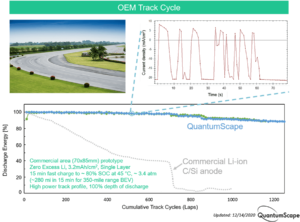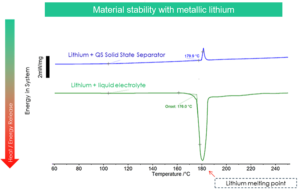 At QuantumScape, we have appreciated the surge in interest in solid-state batteries since we revealed our performance data at our battery showcase. We would like to elaborate on a few aspects of the data we presented at the showcase.
At QuantumScape, we have appreciated the surge in interest in solid-state batteries since we revealed our performance data at our battery showcase. We would like to elaborate on a few aspects of the data we presented at the showcase.
Let’s start by reminding readers that QuantumScape’s battery technology is still in the development stage. We are currently testing battery cells with commercial dimensions of 70 x 85mm but only as a single layer, i.e., one cathode, one solid-state separator, and one in-situ formed lithium-metal anode. As noted in our SEC filings, there is much work ahead of us. Among other tasks, we need to develop multi-layer cells and scale up our manufacturing capabilities. If we are successful in these efforts, we aim to start series production of our battery cells in 2024.
Cycle Life
At our battery showcase, we presented data showing cycle life under a number of different test conditions: aggressive driving conditions at 1C/1C rates; race track driving conditions; and at low temperature (-10 °C).
For typical battery cycle life testing, many batteries are run at C/3 rates, which means the cells are charged in three hours and discharged in three hours. For our cycle life demonstration, we used more aggressive testing conditions of 1C: full charge and discharge of the cell in one hour each. Even under these more strenuous test conditions the QuantumScape single layer cells showed over 1,000 cycles to a median of over 90% energy retention. We report energy, not just capacity, because energy takes into account voltage fade and impedance growth. Note that this test was run at near-room temperature (30 °C), commercially-relevant current density (3.2 mA/cm2) and cathode loading (3.2 mAh/cm2), 100% depth of discharge, modest pressure (3.4 atm), commercial area, and zero lithium on the anode. We are not aware of any other solid-state efforts that have reported this level of performance under all these conditions simultaneously, which we believe is required for commercial viability.

The race track drive cycle is among the harshest of battery cycling tests. Aggressive performance demands — involving repetitive extreme acceleration and braking followed by 15-minute fast-charging — will stress the system more and lead to more rapid degradation than normal driving conditions, which is why conventional lithium-ion BEV energy cells perform poorly on this test, as shown in the chart below. We were therefore very pleased to report that the QuantumScape cell performed significantly better on this test, delivering over 100 full charge-discharge cycles with 100% depth of discharge (i.e., 0-100% state of charge) with 90% retention of energy under these demanding conditions.

In addition to cycling data, we reported performance data for our soli-state material at extreme low temperatures, i.e., -30 degrees C. As the slide below shows, the data shows good energy retention even at these low temperatures — better than the reference state-of-the-art BEV lithium-ion cell shown on that slide. Batteries generally perform worse at low temperatures, but the requirement is to provide enough power to drive safely while the battery system heats itself.
We also reported cycle life data for these single layer cells at -10 degrees C, important for real-world operation, shown on the graph below. We have not seen comparable cycling from any other solid-state effort.
Safety
Finally, the differential scanning calorimetry (DSC) chart below shows what happens when lithium melts in contact with our separator – there is no exothermic reaction as is the case when lithium melts in contact with a liquid electrolyte. We believe that safety in our cell will be improved relative to lithium-ion because we have replaced the combustible polymer separator with a non-oxidizable (i.e., non-combustible) separator that is thermally stable to much higher temperatures than polymers, so it will act as a more effective barrier between anode and cathode.

We believe that the above results, in aggregate, redefine the performance frontier of solid-state batteries as no previous solid-state battery efforts have reported similar results under comparable conditions.
Additional Key Points
Multi-Layering – The next step for us is to utilize our single-layer cells as the building blocks for robust solid-state multi-layer cells. Making multi-layers requires significantly more material, tools and personnel — for example, a 10-layer cell requires fabricating ten times as many separators and cathodes, which requires either ten times as many tools and technicians or larger scale equipment, with multi-quarter lead times either way. In addition, making enough multi-layer cells to get statistically meaningful data requires producing many such cells, which requires automation engineering. This is part of why making a multilayer cell takes time even after one has working single-layer cells meeting performance specifications.
There have been some questions related to whether cathode expansion poses a challenge for multi-layer cell construction. Typical cathode material expansion is relatively small (1-5%) and occurs in both lithium-ion and solid-state batteries, so we do not expect this expansion to introduce any meaningful difficulty making multilayer solid-state batteries relative to conventional batteries. If cathode expansion were indeed a failure mode, it would show up in the single-layer cell cycling data as well as multilayer cells. Given the >1,100 cycle life data we’ve shown on single layer cells, this is clearly not the case.
Pressure – Our testing was conducted at a moderate pressure of 3.4 atm which is substantially lower than the pressure required for some other lithium metal systems, which can require 10-20 atm. We will continue to work to reduce this moderate level of pressure to lower levels as we develop our battery technology.
Dendrites and Stiffness – Our solid-state separator is flexible and is demonstrably not stiff.
 Solving the problem of dendrites is very difficult as lithium can dendrite through polymers, single crystals, and glassy materials with no grain boundaries, as well as polycrystalline materials with grain boundaries, so none of those microstructures is by itself a solution to the dendrite problem. That is why we have been so excited at QuantumScape to have developed a material and system that we believe can address this issue.
Solving the problem of dendrites is very difficult as lithium can dendrite through polymers, single crystals, and glassy materials with no grain boundaries, as well as polycrystalline materials with grain boundaries, so none of those microstructures is by itself a solution to the dendrite problem. That is why we have been so excited at QuantumScape to have developed a material and system that we believe can address this issue.
Energy Density and Cost – Our target is to stack several dozen of our single layer unit cells together into a multilayer cell and achieve a target energy density of 1,000 Wh/L, enabled by the elimination of the anode host material. This would allow greater range than today’s state-of-the-art commercially shipping BEV cells, such as the 2170 cell used in the Tesla Model 3 which has an energy density of 713 Wh/L, as reported by CleanTechnica. The higher energy density design targeted by the QuantumScape cells also reduces cost by eliminating both the anode material and the anode manufacturing line, while simplifying the formation and aging process, one of the most expensive parts of the battery manufacturing process. Our separator consists of generally inexpensive precursor materials and utilizes processes suitable for high volume continuous flow production.
In summary, when evaluating battery performance test data, it is important to note that there are many compromises in test conditions that can be made when showing battery cycle life data, many of which result in a cell that is not capable of meeting commercial requirements. What makes QuantumScape’s performance data interesting is not just that it shows over 1,000 cycles with good capacity retention, but that it does so under commercially-relevant conditions, including high current density, close-to-room temperature, full depth of discharge, modest pressure, zero excess lithium, and commercially-relevant area and cathode loading. We hope this explanation helps provide a better understanding of the data we have shared and our progress towards developing solid-state lithium-metal batteries.

















